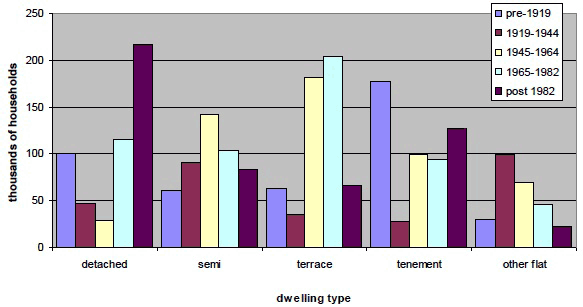Scottish House Condition Survey: Key Findings 2011
The Scottish House Condition Survey (SHCS) combines both an interview with occupants and a physical inspection of dwellings to build up a picture of Scotland’s occupied housing stock. This is the eighth ‘Key Findings’ report since the SHCS changed to a continuous format in 2003.
2 Key Attributes of the Scottish Housing Stock
15. Table 2 and Figure 1 show the age of the 2011 housing stock by dwelling type[4]. They show that detached houses have dominated new-builds since 1982. This differs from dwellings from earlier periods; a large proportion of remaining pre-1919 dwellings are tenements, whilst dwellings from the 1945-1982 period are predominantly semi-detached and terraced housing. Definitions of the dwelling types used in the SHCS can be found in paragraph 167.
16. Table 3 shows that about one fifth of the stock is now over 92 years old and a third of the housing stock is over 67 years old. Twenty-two percent of the stock has been built within the last 30 years.
Table 2 Type of dwelling by age of dwelling (000s)
| Age of dwelling | Detached | Semi-detached | Terraced | Tenement | Other flats | Total | Unweighted Sample size |
|---|---|---|---|---|---|---|---|
| 000s | 000s | 000s | 000s | 000s | 000s | ||
| Pre 1919 | 100 | 61 | 63 | 178 | 56 | 459 | 590 |
| 1919-1944 | 47 | 91 | 35 | 29 | 100 | 303 | 422 |
| 1945-1964 | 29 | 142 | 182 | 100 | 70 | 523 | 747 |
| 1965-1982 | 115 | 103 | 204 | 94 | 48 | 565 | 768 |
| Post-1982 | 217 | 84 | 67 | 128 | 23 | 519 | 692 |
| Total | 509 | 482 | 551 | 529 | 297 | 2,368 | 3,219 |
| Unweighted Sample size |
801 | 691 | 781 | 557 | 389 | 3,219 |
Source: SHCS 2011
Figure 1 Type of dwelling by age of dwelling (000s)

Source: SHCS 2011
Table 3 Type of dwelling by age of dwelling (Column %)
| Age of dwelling | Detached | Semi-detached | Terraced | Tenement | Other flats | Total |
|---|---|---|---|---|---|---|
| % | % | % | % | % | % | |
| Pre 1919 | 20 | 13 | 11 | 34 | 19 | 19 |
| 1919-1944 | 9 | 19 | 6 | 5 | 34 | 13 |
| 1945-1964 | 6 | 29 | 33 | 19 | 24 | 22 |
| 1965-1982 | 23 | 21 | 37 | 18 | 16 | 24 |
| Post-1982 | 43 | 17 | 12 | 24 | 8 | 22 |
| Total | 100 | 100 | 100 | 100 | 100 | 100 |
| Unweighted Sample size |
801 | 691 | 781 | 557 | 389 | 3,219 |
Source: SHCS 2011
17. The SHCS includes a variable covering whether dwellings are on or off the gas-grid. Dwellings are classified as 'on the gas grid' if there is a medium/low pressure gas pipe in the 'mapping area'[5]. Further analysis of households which are on or near a gas grid shows whether they use gas for heating.
18. Table 4 shows the figures for whether a dwelling is on or off the gas grid by urban/rural indicator. It shows that 99% of dwellings in urban areas are on or near the gas grid compared to 48% of dwellings in rural areas. Overall in Scotland, 91% of dwellings are on the gas grid.
Table 4 Dwellings on/off the Gas Grid by urban/rural indicator (000s and %)
| Gas Grid Coverage | Urban | Rural | Total | Un-weighted sample size |
|
|---|---|---|---|---|---|
| On gas grid | 000s | 1,956 | 191 | 2,147 | 2,723 |
| Row % | 91 | 9 | 100 | ||
| Col % | 99 | 48 | 91 | ||
| Not on gas grid | 000s | 12 | 206 | 218 | 493 |
| Row % | 6 | 94 | 100 | ||
| Col % | 1 | 52 | 9 | ||
| All Dwellings | 000s | 1,969 | 397 | 2,365 | 3,216 |
| Row % | 83 | 17 | 100 | ||
| Col % | 100 | 100 | 100 | ||
| Unweighted Sample size |
2,497 | 719 | 3,216 | ||
Source: SHCS 2011
Contact
Email: Ganka Mueller
There is a problem
Thanks for your feedback